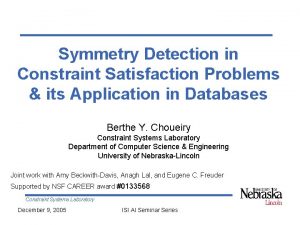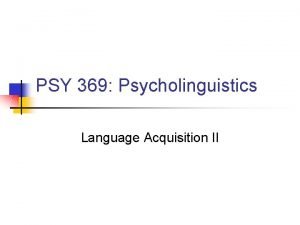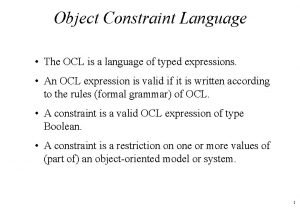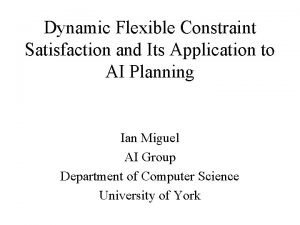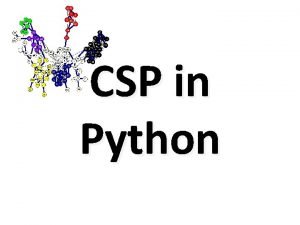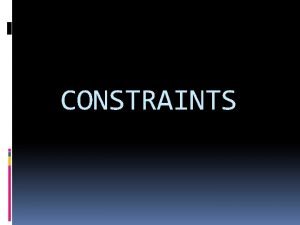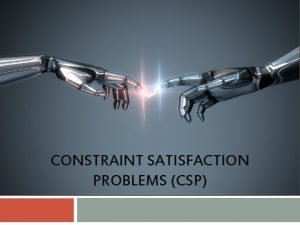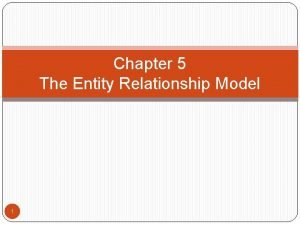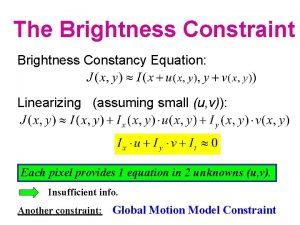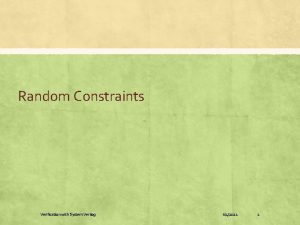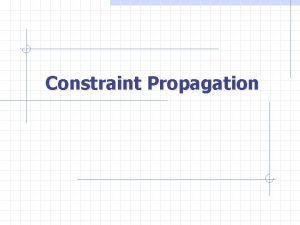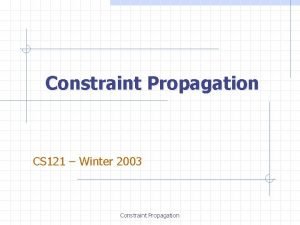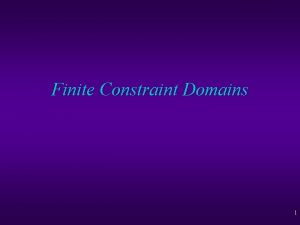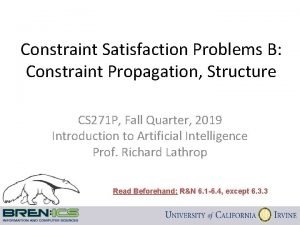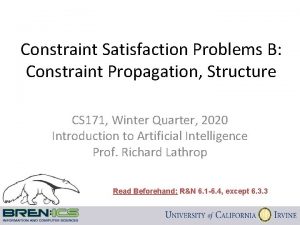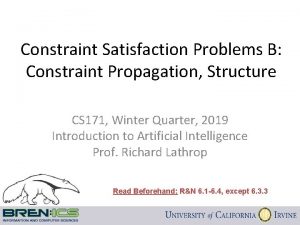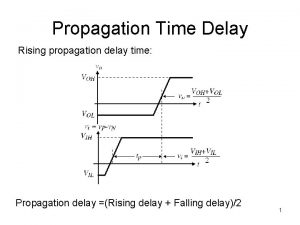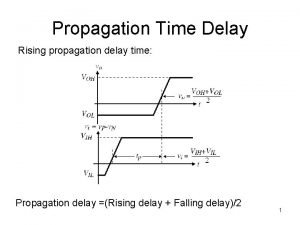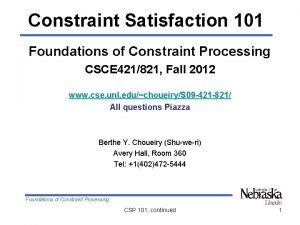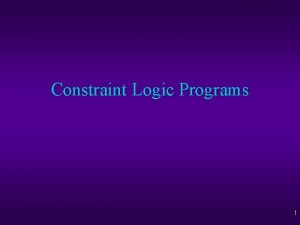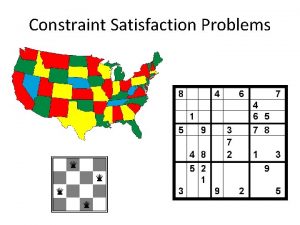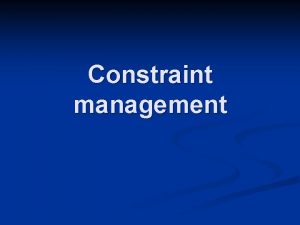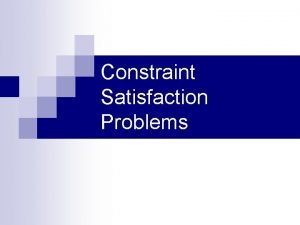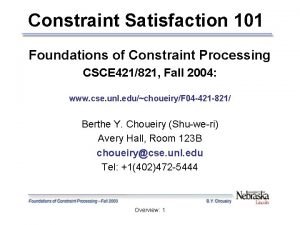Constraint Propagation Constraint Propagation is the process of































































- Slides: 63

Constraint Propagation

Constraint Propagation … … is the process of determining how the possible values of one variable affect the possible values of other variables Constraint Propagation 2

Forward Checking After a variable X is assigned a value v, look at each unassigned variable Y that is connected to X by a constraint and deletes from Y’s domain any value that is inconsistent with v Constraint Propagation 3

Map Coloring NT Q WA T NSW SA V WA NT Q NSW V SA T RGB RGB Constraint Propagation 4

Map Coloring NT Q WA T NSW SA V WA NT Q NSW V SA T RGB RGB R GB RGB RGB Constraint Propagation 5

Map Coloring NT Q WA T NSW SA V WA NT Q NSW V SA T RGB RGB R GB RGB RGB R B G RB RGB Constraint Propagation 6

Map Coloring NT Q WA T NSW SA V WA NT RGB R Impossible assignments that forward Q checking NSWdo not V detect SA T RGB RGB RGB R B G RB RGB R B G R B Constraint Propagation RGB 7

constraint propagation Constraint Propagation 8

Edge Labeling in Computer Vision Russell and Norvig: Chapter 24, pages 745 -749 Constraint Propagation 9

Edge Labeling Constraint Propagation 10

Edge Labeling Constraint Propagation 11

Edge Labeling + – Constraint Propagation 12

Edge Labeling + + + - + + Constraint Propagation + 13

Junction Label Sets + - + - - + + - - - + + + (Waltz, 1975; Mackworth, 1977) Constraint Propagation 14

Edge Labeling as a CSP A variable is associated with each junction The domain of a variable is the label set of the corresponding junction Each constraint imposes that the values given to two adjacent junctions give the same label to the joining edge Constraint Propagation 15

Edge Labeling + + + - -+ + Constraint Propagation 16

Edge Labeling + + - - - Constraint Propagation - + + + 17

Edge Labeling + + + Constraint Propagation + - - + + 18

Edge Labeling + + - + + + - Constraint Propagation 19

Removal of Arc Inconsistencies REMOVE-ARC-INCONSISTENCIES(J, K) removed false X label set of J Y label set of K For every label y in Y do n If there exists no label x in X such that the constraint (x, y) is satisfied then w Remove y from Y w If Y is empty then contradiction true w removed true Label set of K Y Return removed Constraint Propagation 20

CP Algorithm for Edge Labeling Associate with every junction its label set contradiction false Q stack of all junctions while Q is not empty and not contradiction do n J UNSTACK(Q) n For every junction K adjacent to J do w If REMOVE-ARC-INCONSISTENCIES(J, K) then n STACK(K, Q) (Waltz, 1975; Mackworth, 1977) Constraint Propagation 21

General CP for Binary Constraints Algorithm AC 3 contradiction false Q stack of all variables while Q is not empty and not contradiction do n X UNSTACK(Q) n For every variable Y adjacent to X do w If REMOVE-ARC-INCONSISTENCIES(X, Y) then n STACK(Y, Q) Constraint Propagation 22

General CP for Binary Constraints Algorithm AC 3 contradiction false Q stack of all variables while Q is not empty and not contradiction do n X UNSTACK(Q) n For every variable Y adjacent to X do w If REMOVE-ARC-INCONSISTENCY(X, Y) then n STACK(Y, Q) REMOVE-ARC-INCONSISTENCY(X, Y) removed false For every value y in the domain of Y do n If there exists no value x in the domain of X such that the constraints on (x, y) is satisfied then w Remove y from the domain of Y w If Y is empty then contradiction true w removed true Constraint Propagation 23 Return removed

Complexity Analysis of AC 3 n = number of variables d = number of values per variable s = maximum number of constraints on a pair of variables Each variables is inserted in Q up to d times REMOVE-ARC-INCONSISTENCY takes O(d 2) time CP takes O(n s d 3) time Constraint Propagation 24

Is AC 3 All What is Needed? NO! {1, 2} X X Y X Z {1, 2} Y Y Z Z {1, 2} Constraint Propagation 25

Solving a CSP Interweave constraint propagation, e. g. , • forward checking • AC 3 and backtracking + Take advantage of the CSP structure Constraint Propagation 26

4 -Queens Problem 1 2 3 4 X 1 {1, 2, 3, 4} X 2 {1, 2, 3, 4} X 3 {1, 2, 3, 4} X 4 {1, 2, 3, 4} 1 2 3 4 Constraint Propagation 27

4 -Queens Problem 1 2 3 4 X 1 {1, 2, 3, 4} X 2 {1, 2, 3, 4} X 3 {1, 2, 3, 4} X 4 {1, 2, 3, 4} 1 2 3 4 Constraint Propagation 28

4 -Queens Problem 1 2 3 4 X 1 {1, 2, 3, 4} X 2 {1, 2, 3, 4} X 3 {1, 2, 3, 4} X 4 {1, 2, 3, 4} 1 2 3 4 Constraint Propagation 29

4 -Queens Problem 1 2 3 4 X 1 {1, 2, 3, 4} X 2 {1, 2, 3, 4} X 3 {1, 2, 3, 4} X 4 {1, 2, 3, 4} 1 2 3 4 Constraint Propagation 30

4 -Queens Problem 1 2 3 4 X 1 {1, 2, 3, 4} X 2 {1, 2, 3, 4} X 3 {1, 2, 3, 4} X 4 {1, 2, 3, 4} 1 2 3 4 Constraint Propagation 31

4 -Queens Problem 1 2 3 4 X 1 {1, 2, 3, 4} X 2 {1, 2, 3, 4} X 3 {1, 2, 3, 4} X 4 {1, 2, 3, 4} 1 2 3 4 Constraint Propagation 32

4 -Queens Problem 1 2 3 4 X 1 {1, 2, 3, 4} X 2 {1, 2, 3, 4} X 3 {1, 2, 3, 4} X 4 {1, 2, 3, 4} 1 2 3 4 Constraint Propagation 33

4 -Queens Problem 1 2 3 4 X 1 {1, 2, 3, 4} X 2 {1, 2, 3, 4} X 3 {1, 2, 3, 4} X 4 {1, 2, 3, 4} 1 2 3 4 Constraint Propagation 34

4 -Queens Problem 1 2 3 4 X 1 {1, 2, 3, 4} X 2 {1, 2, 3, 4} X 3 {1, 2, 3, 4} X 4 {1, 2, 3, 4} 1 2 3 4 Constraint Propagation 35

4 -Queens Problem 1 2 3 4 X 1 {1, 2, 3, 4} X 2 {1, 2, 3, 4} X 3 {1, 2, 3, 4} X 4 {1, 2, 3, 4} 1 2 3 4 Constraint Propagation 36

Structure of CSP If the constraint graph contains multiple components, then one independent CSP per component NT WA Q NSW SA T V Constraint Propagation 37

Structure of CSP If the constraint graph contains multiple components, then one independent CSP per component If the constraint graph is a tree (no loop), then the CSP can be solved efficiently Constraint Propagation 38

Constraint Tree X Y Z U V (X, Y, Z, U, V, W) W Constraint Propagation 39

Constraint Tree Order the variables from the root to the leaves (X 1, X 2, …, Xn) For j = n, n-1, …, 2 do REMOVE-ARC-INCONSISTENCY(Xj, Xi) where Xi is the parent of Xj Assign any legal value to X 1 For j = 2, …, n do n assign any value to Xj consistent with the value assigned to Xi, where Xi is the parent of Xj Constraint Propagation 40

Structure of CSP If the constraint NT graph contains multiple Qindependent CSP per components, then one WA component NSW SA If the constraint graph. V is a tree, then the CSP can be solved efficiently Whenever a variable is assigned a value by the backtracking algorithm, propagate this value and remove the variable from the constraint graph Constraint Propagation 41

Structure of CSP If the constraint NT graph contains multiple Qindependent CSP per components, then one WA component NSW If the constraint graph. V is a tree, then the CSP can be solved in linear time Whenever a variable is assigned a value by the backtracking algorithm, propagate this value and remove the variable from the constraint graph Constraint Propagation 42

Over-Constrained Problems Weaken an over-constrained problem by: n n Enlarging the domain of a variable Loosening a constraint Removing a variable Removing a constraint Constraint Propagation 43

Non-Binary Constraints So far, all constraints have been binary (two variables) or unary (one variable) Constraints with more than 2 variables would be difficult to propagate Theoretically, one can reduce a constraint with k>2 variables to a set of binary constraints by introducing additional variables Constraint Propagation 44

When to Use CSP Techniques? When the problem can be expressed by a set of variables with constraints on their values When constraints are relatively simple (e. g. , binary) When constraints propagate well (AC 3 eliminates many values) When the solutions are “densely” distributed in the space of possible assignments Constraint Propagation 45

Summary Forward checking Constraint propagation Edge labeling in Computer Vision Interweaving CP and backtracking Exploiting CSP structure Weakening over-constrained CSP Constraint Propagation 46

Game Playing

Games as search problems Chess, Go Simulation of war (war game) 스타크래프트의 전투 Claude Shannon, Alan Turing Chess program (1950년대) Constraint Propagation 48

Contingency problems The opponent introduces uncertainty 마이티에서는 co-work이 필요 고스톱에서는 co-work방지가 필요 Hard to solve in chess, 35100 possible nodes, 1040 different legal positions Time limits how to make the best use of time to reach good decisions Pruning, heuristic evaluation function Constraint Propagation 49

Perfect decisions in two person games The initial state, A set of operators, A terminal test, A utility function (payoff function) Mini-max algorithm, Negmax algorithms Constraint Propagation 50

Mini-max algorithm (AND-OR tree) Constraint Propagation 51

상대방의 관점 Constraint Propagation 52

Negmax Knuth and Moore (1975) F(n) = f(n), if n has no successors F(n) = max{-F(n 1), …, -F(nk)}, if n has successors n 1, …, nk Constraint Propagation 53

The Negmax formalism Constraint Propagation 54

Imperfect Decisions utility function evaluation terminal test cutoff test Evaluation function : : : an estimate of the utility of the game from a given position Chess material value (장기도 유사) Weighted linear function w 1 f 1+w 2 f 2+…. +wnfn Constraint Propagation 55

Cutting off search To set a fixed depth limit, so that the cutoff test succeeds for all nodes at or below depth d iterative deepening until time runs out 위험이 있을 수 있다 Quiescent posiiton : : : unlikely to exhibit wild swings in value in near future Quiescent search : : Non-quiescent search extra search to find quiescent position Horizon problem Constraint Propagation 56

Alpha-beta pruning Eliminate unnecessary evaluations Pruning Constraint Propagation 57

Alpha-beta pruning Alpha cutoff Beta cutoff Constraint Propagation 58

Negmax representation Constraint Propagation 59

Example Constraint Propagation 60

Games with Chance nodes expected value Backgammon, 윷놀이 Expectimax value Constraint Propagation 61

A backgammon position Constraint Propagation 62

Comparision MAX 2. 1 DICE . 9 . 1 MIN 2 . 9 3 2 2 1 3 3 1. 3 21 . 9 20 4 1 1 A 2 A 1 4 4 20 Constraint Propagation 40. 9. 1 30 20 30 . 9 1 30 . 1 400 1 1 400 63
 Hình ảnh bộ gõ cơ thể búng tay
Hình ảnh bộ gõ cơ thể búng tay Slidetodoc
Slidetodoc Bổ thể
Bổ thể Tỉ lệ cơ thể trẻ em
Tỉ lệ cơ thể trẻ em Voi kéo gỗ như thế nào
Voi kéo gỗ như thế nào Tư thế worm breton
Tư thế worm breton Chúa sống lại
Chúa sống lại Các môn thể thao bắt đầu bằng tiếng chạy
Các môn thể thao bắt đầu bằng tiếng chạy Thế nào là hệ số cao nhất
Thế nào là hệ số cao nhất Các châu lục và đại dương trên thế giới
Các châu lục và đại dương trên thế giới Công thức tính độ biến thiên đông lượng
Công thức tính độ biến thiên đông lượng Trời xanh đây là của chúng ta thể thơ
Trời xanh đây là của chúng ta thể thơ Cách giải mật thư tọa độ
Cách giải mật thư tọa độ Làm thế nào để 102-1=99
Làm thế nào để 102-1=99 Phản ứng thế ankan
Phản ứng thế ankan Các châu lục và đại dương trên thế giới
Các châu lục và đại dương trên thế giới Thơ thất ngôn tứ tuyệt đường luật
Thơ thất ngôn tứ tuyệt đường luật Quá trình desamine hóa có thể tạo ra
Quá trình desamine hóa có thể tạo ra Một số thể thơ truyền thống
Một số thể thơ truyền thống Cái miệng xinh xinh thế chỉ nói điều hay thôi
Cái miệng xinh xinh thế chỉ nói điều hay thôi Vẽ hình chiếu vuông góc của vật thể sau
Vẽ hình chiếu vuông góc của vật thể sau Thế nào là sự mỏi cơ
Thế nào là sự mỏi cơ đặc điểm cơ thể của người tối cổ
đặc điểm cơ thể của người tối cổ V cc cc
V cc cc Vẽ hình chiếu đứng bằng cạnh của vật thể
Vẽ hình chiếu đứng bằng cạnh của vật thể Phối cảnh
Phối cảnh Thẻ vin
Thẻ vin đại từ thay thế
đại từ thay thế điện thế nghỉ
điện thế nghỉ Tư thế ngồi viết
Tư thế ngồi viết Diễn thế sinh thái là
Diễn thế sinh thái là Các loại đột biến cấu trúc nhiễm sắc thể
Các loại đột biến cấu trúc nhiễm sắc thể So nguyen to
So nguyen to Tư thế ngồi viết
Tư thế ngồi viết Lời thề hippocrates
Lời thề hippocrates Thiếu nhi thế giới liên hoan
Thiếu nhi thế giới liên hoan ưu thế lai là gì
ưu thế lai là gì Sự nuôi và dạy con của hổ
Sự nuôi và dạy con của hổ Sự nuôi và dạy con của hổ
Sự nuôi và dạy con của hổ Hệ hô hấp
Hệ hô hấp Từ ngữ thể hiện lòng nhân hậu
Từ ngữ thể hiện lòng nhân hậu Thế nào là mạng điện lắp đặt kiểu nổi
Thế nào là mạng điện lắp đặt kiểu nổi Csp problem in ai
Csp problem in ai Capacity and constraint management
Capacity and constraint management De luca
De luca Mutual exclusivity constraint
Mutual exclusivity constraint Nonlinear planning using constraint posting
Nonlinear planning using constraint posting Contoh lrs
Contoh lrs Ocl language
Ocl language Mutual exclusivity constraint
Mutual exclusivity constraint Integrity constraint
Integrity constraint Constraint satisfaction problem applications
Constraint satisfaction problem applications Pip install python-constraint
Pip install python-constraint Examples of holonomic constraints
Examples of holonomic constraints Arc consistency sudoku
Arc consistency sudoku Intertemporal budget constraint
Intertemporal budget constraint Existence dependence
Existence dependence Intertemporal budget constraint
Intertemporal budget constraint Budget constraint graph example
Budget constraint graph example Jelaskan animasi dengan object constraint
Jelaskan animasi dengan object constraint Principles assumptions and constraints of accounting
Principles assumptions and constraints of accounting Constraints of accounting principles
Constraints of accounting principles Brightness constancy equation
Brightness constancy equation Systemverilog implication constraint
Systemverilog implication constraint










































